Weekly Reports from Jordan
Choose Year: or Choose week
Archaeological Impressions: Week 3
by Kent V. Bramlett
 If we were to name a theme of the week, it would have to be stratigraphy. In archaeology, stratigraphy refers to the sequential and contextual relationships between the earth layers and architectural features we are digging up. A correct interpretation of the stratigraphy indicates the sequence of ancient building activity, habitation, and destructive events that produced the ruins we are excavating. This tells us which structures were older, which were contemporary, and which came later, and, ultimately, what time period they belonged to. Thus, good stratigraphic control in excavation and careful attention to all the pieces of the puzzle are necessary to do good archaeology and come to a coherent understanding of what the walls and artifacts mean and to reconstruct the lives and communities of the ancient peoples we are digging up.
If we were to name a theme of the week, it would have to be stratigraphy. In archaeology, stratigraphy refers to the sequential and contextual relationships between the earth layers and architectural features we are digging up. A correct interpretation of the stratigraphy indicates the sequence of ancient building activity, habitation, and destructive events that produced the ruins we are excavating. This tells us which structures were older, which were contemporary, and which came later, and, ultimately, what time period they belonged to. Thus, good stratigraphic control in excavation and careful attention to all the pieces of the puzzle are necessary to do good archaeology and come to a coherent understanding of what the walls and artifacts mean and to reconstruct the lives and communities of the ancient peoples we are digging up.
Important, extremely clear, game-changing stratigraphy jumped out at us this week in all fields.
 In Field A, Stephanie and team finished removing some walls from an Iron IIB occupation level (8th century BC) in order to excavate more of our 12th-century village beneath. However, we had some unanswered questions about the Iron IIB structures. Observations from the past field season had hinted to us that the Iron IIB house was likely not the unitary structure it had been thought to be. This was part of our reason, along with serious inter-seasonal collapse, for removing more of it. With the evidence of a visible cut through the pavement and walls of the original building, we now thought the eastern extent of the building had been added later.
In Field A, Stephanie and team finished removing some walls from an Iron IIB occupation level (8th century BC) in order to excavate more of our 12th-century village beneath. However, we had some unanswered questions about the Iron IIB structures. Observations from the past field season had hinted to us that the Iron IIB house was likely not the unitary structure it had been thought to be. This was part of our reason, along with serious inter-seasonal collapse, for removing more of it. With the evidence of a visible cut through the pavement and walls of the original building, we now thought the eastern extent of the building had been added later. 
 Careful sectioning of the foundations of this building succeeded in detecting a “textbook” foundation trench for the eastern wall in question. Though this wall was founded at a deeper level, it was built later. A foundation trench had been dug into earlier material and the first courses of the wall laid in that ditch and backfilled to level with the intended floor. In fact, it appeared the new wall had never really been attached to the older structure through which it cut. The old wall which was cut for the new construction was never fully repaired to abut the new wall. We now suspect a temporal gap in use of the two parts, though both were used during the Iron IIB period as indicated by the style of pottery found on both floors.
Careful sectioning of the foundations of this building succeeded in detecting a “textbook” foundation trench for the eastern wall in question. Though this wall was founded at a deeper level, it was built later. A foundation trench had been dug into earlier material and the first courses of the wall laid in that ditch and backfilled to level with the intended floor. In fact, it appeared the new wall had never really been attached to the older structure through which it cut. The old wall which was cut for the new construction was never fully repaired to abut the new wall. We now suspect a temporal gap in use of the two parts, though both were used during the Iron IIB period as indicated by the style of pottery found on both floors.
 There was also excitement Field A with the discovery, this week, of two bronze weapons in the 12th-century destruction debris. With the removal of the Iron IIB floor, team A began excavating into the deep layers of burned brick that filled the rooms below. While sifting excavated burned debris from the house, Sashiere’s team found a bronze weapon point. Just the day before, Tevin found a bronze spear point between the south wall and the city wall.
There was also excitement Field A with the discovery, this week, of two bronze weapons in the 12th-century destruction debris. With the removal of the Iron IIB floor, team A began excavating into the deep layers of burned brick that filled the rooms below. While sifting excavated burned debris from the house, Sashiere’s team found a bronze weapon point. Just the day before, Tevin found a bronze spear point between the south wall and the city wall.  As he continued digging, he found the haft of the blade where it would have been attached to the wooden spear shaft.
As he continued digging, he found the haft of the blade where it would have been attached to the wooden spear shaft.
 Field H also had an important week. Teams excavating on both sides of the south wall of the building confirmed that early parts of it were indeed the building’s southern terminus. Removal of the later additions to the south wall of the house revealed indications of an internal face to the wall.
Field H also had an important week. Teams excavating on both sides of the south wall of the building confirmed that early parts of it were indeed the building’s southern terminus. Removal of the later additions to the south wall of the house revealed indications of an internal face to the wall.  This means the wall was widened at some point. The stratigraphy indicates this widening occurred contemporary to the use of the building. We had actually though this might not be the case and more excavation of the debris in the broad room at the back of the house will be necessary to confirm what we now think. While dismantling the late Iron I stones from the wall, a scarab seal was found by Adel, one of Filed H’s Jordanian workers. A number of beads and small finds have turned up in the walls dismantled in Field H, and it seems the items were placed as dedicatory offerings in the wall when it was constructed. This kind of practice is known from ethnographic studies in some contemporary traditional societies.
This means the wall was widened at some point. The stratigraphy indicates this widening occurred contemporary to the use of the building. We had actually though this might not be the case and more excavation of the debris in the broad room at the back of the house will be necessary to confirm what we now think. While dismantling the late Iron I stones from the wall, a scarab seal was found by Adel, one of Filed H’s Jordanian workers. A number of beads and small finds have turned up in the walls dismantled in Field H, and it seems the items were placed as dedicatory offerings in the wall when it was constructed. This kind of practice is known from ethnographic studies in some contemporary traditional societies.
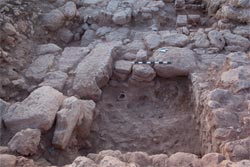 Field L removed the remaining fragments of the Hellenistic farmstead walls which were mostly cleared in 2011. This allowed excavation to reveal the contiguous late Iron II construction below. The goal is to clarify the connections among the Iron II walls and excavate test probes against the “megalithic” stones which may or may not date from that same time period. Thus, this week saw a lot of change in the appearance of the field as walls disappeared, and new connections appeared as rubble was cleared and underlying stones were articulated, brushed, and photographed with our boom photography system.
Field L removed the remaining fragments of the Hellenistic farmstead walls which were mostly cleared in 2011. This allowed excavation to reveal the contiguous late Iron II construction below. The goal is to clarify the connections among the Iron II walls and excavate test probes against the “megalithic” stones which may or may not date from that same time period. Thus, this week saw a lot of change in the appearance of the field as walls disappeared, and new connections appeared as rubble was cleared and underlying stones were articulated, brushed, and photographed with our boom photography system.
